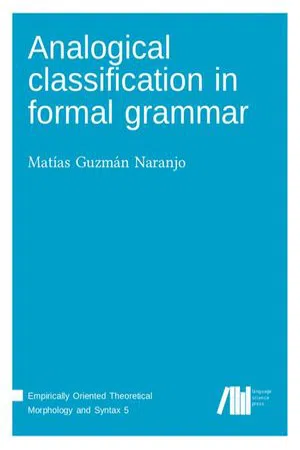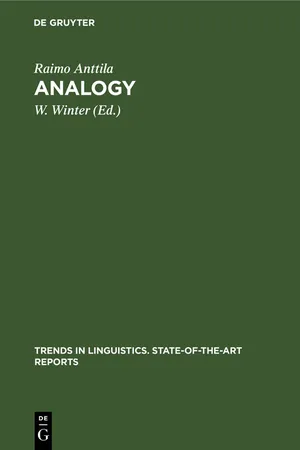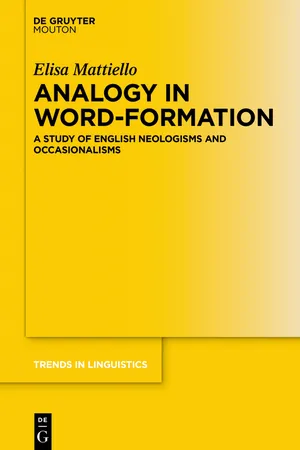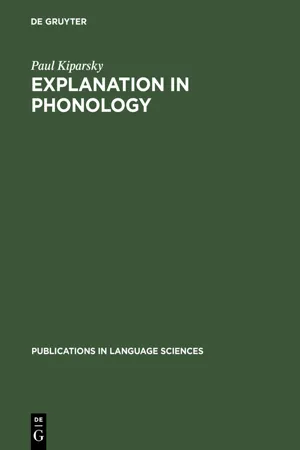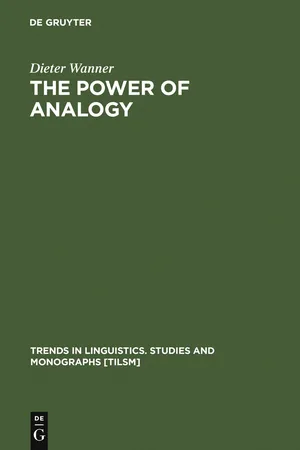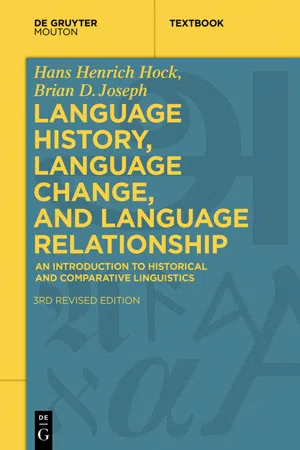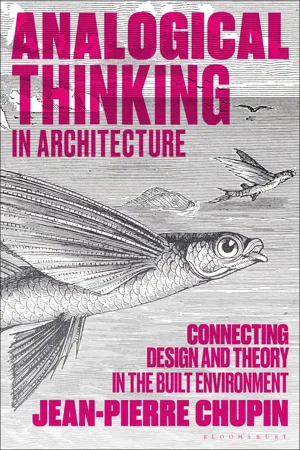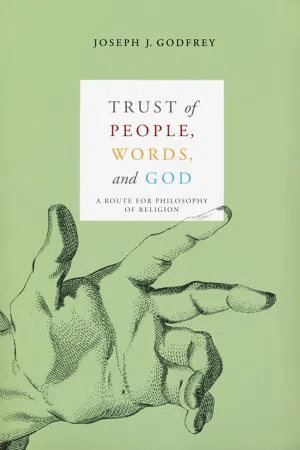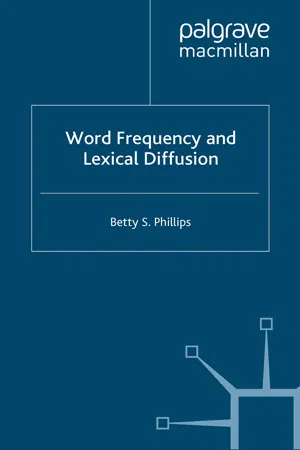Languages & Linguistics
Analogy
An analogy in linguistics refers to a comparison between two things, often used to explain a complex concept by drawing parallels with a more familiar idea. It helps to clarify and illustrate linguistic principles and structures by highlighting similarities between different language elements or processes. Analogies can aid in understanding language acquisition, grammar, and phonetics.
Written by Perlego with AI-assistance
Related key terms
1 of 5
11 Key excerpts on "Analogy"
- eBook - PDF
- Matias Guzmán Naranjo(Author)
- 2019(Publication Date)
- Language Science Press(Publisher)
2 Remarks on Analogy Analogy can be defned in many ways, and it can be ascribed to various kinds o f processes. Te literature on Analogy is vast and covers all sorts of phenomena and domains. Most work on it focuses on phenomena that are not directly relevant to the overall question of this book, but which are related in some way or another. In linguistics, the term Analogy is usually employed whenever a process makes reference to direct comparison of surface items without making use of general rules, or when phonological or semantic similarities are involved, which are not easily captured as categorical generalizations. However, as a concept, Analogy is rather fuzzy, and has no precise or unique de fnition. In the following subsections, I briefy mention some o f the di ferent phenomena for which the term Analogy has been used, and in the fnal section o f this chapter I focus on the actual kind of systems I will address in the present book. Making justice to the history of Analogy in linguistics would require a book (or several) of its own. Extensive discussions of the development of Analogy as a concept in linguistics can be found in An tila (1977), Rainer (2013) and, mos t extensively, Itkonen (2005). 2.1 Te many meanings of Analogy 2.1.1 Single case Analogy Te simplest form of Analogy is a similarity relation between two single items that plays a certain role in triggering or blocking a phonological or morpholog-ical process. An example of this type of Analogy has been proposed to explain unpredictable new coinages and neologisms that make use of unproductive mor-phemes or non-morphemes (Motsch 1977: 195, see also Bu terwor th 1983). In such cases, a newly coined form does not make use of any derivational morphologi-cal process but is directly built on the basis of some existing form instead. Booij (2010: 89) cites the examples in (1): (1) a. angst-haas → paniek-haas fear-hare panic-hare ‘terrifed person’ → ‘panicky person’ - eBook - PDF
The Changing English Language
Psycholinguistic Perspectives
- Marianne Hundt, Sandra Mollin, Simone E. Pfenninger(Authors)
- 2017(Publication Date)
- Cambridge University Press(Publisher)
In this chapter, I will discuss the possible effects of analogical reasoning for linguistic category formation from an emergentist and usage-based perspective, and then characterize the interaction of different processes of analogical reasoning in language development, with a special focus on regular/irregular morphology and argument structure. The focus on lan- guage acquisition is chosen because, in longitudinal studies on language development, we can trace the effect of analogical reasoning on a certain linguistic state over time. 215 I will conclude with a discussion on the similarities and differences between acquisition and change. 10.2 Definition: What Is Analogy? 10.2.1 Analogical Reasoning from a Cognitive Science Perspective Analogy is a domain-general form of structure mapping between a source and a target (Gentner 1983). Such mappings can be based on perceptual similarity when one notices the similarity between two blue objects, or they can be relational when one sees two rows of three different objects each and notices that two of these objects share the position as the middle one without being physically similar. Markman and Gentner (1993) demonstrate this with the example of two sets of three geometrical objects in a row (see Figure 10.1). The squares in Set (a) are bigger than those in Set (b): the medium-sized square in Set (b) is identical in size to the smallest square in Set (a): they are object matches because they share the same perceptible attributes. By contrast, the Analogy between the smallest square in Set (a) and the small square in Set (b) is a relational one: they are different in size, but both are the smallest in their set (Markman and Gentner 1993). To give a linguistic example, mappings can be based on physical simi- larity or on abstract relations: In morphology, we find patterns based on physical similarity in allophonic variation, where a stem with a certain coda is inflected with a particular allomorph. - eBook - PDF
- Raimo Anttila, W. Winter(Authors)
- 2019(Publication Date)
- De Gruyter Mouton(Publisher)
1.3 Analogical argument In the mid-1960s transformational grammarians launched an attack against Analogy (Kiparsky 1965, Postal 1968, King 1969), and this was also the synchronic stance: Chomsky (1966: 12) termed Analogy a vague metaphor, and metaphor itself a semi-grammatical phenomenon (1964). This was a reaction against the Neogrammarians and American structuralists who had attributed the creative aspect of language to Analogy, one of the reasons for the generativists being that Analogy is supposedly such a surface phenom-enon. This attack missed the whole point, and since Dinneen's answer to Analogy (1968) and Reddy's (1969) to metaphor have been ignored, the matter must be mentioned once more. Ever since antiquity an Analogy has been a relation of similarity, whose types can be classified according to 1) the number of terms involved, 2) the bases for the Analogy affirmed, or 3) the types of terms entering into the Analogy (Dinneen 98). According to the number of terms we have A: B 17 with two terms, A: B = B : C (the mean) with three, and A: B = C: D (proportion) with four. The first type is the rather arbitrary one based on perceptual judgement and similarity which can be unpredictable (e.g. sister : brother as kinship terms on a certain axis), the latter two are dia-grams which derive from mathematics. In fact, 'proportion' is the Latin translation of Greek 'Analogy'. We have already seen that icons can reach truths beyond the truths al-ready observed. Anchoring such a diagram into the known we can use the other end to (dis)cover new territory. In this sense analogies are utterly essential parts of all theories, crucial for explanation and understanding and all formal definition (Hesse 1966, Kaplan 1964, Dinneen 1968). Analogy is the only way to extend a dynamic theory. Models are in fact scientific metaphors, they are diagrams of the scientist's experience. Ana-logy is particularly valuable when the object of investigation is not directly observable. - eBook - ePub
Analogy in Word-formation
A Study of English Neologisms and Occasionalisms
- Elisa Mattiello(Author)
- 2017(Publication Date)
- De Gruyter Mouton(Publisher)
Hence, Analogy is a relevant concept to all morphological categories, disregarding the grammaticality vs. marginality vs. extra-grammaticality of the morphological process or operation through which a word is formed. In particular, surface analogies recur throughout the spectrum from rule-based to extra-grammatical formations (Mattiello 2016). However, Klégr and Čermák’s (2010: 235) statement that “all word-formation … has some kind of Analogy as its underlying principle” is to some extent inaccurate. To be analogical, a formation must be based on a precise model identifiable as either one word or a series/word family, and target and model should be analysable according to a proportional equation (1.3). What can be stated, instead, is that words (or word series) belonging to all word-formation categories can function as models for the analogical process.3.4Psycholinguistic aspects of analogical word-formation
Hitherto, the perspective from which Analogy has been dealt with is that of a linguistic classification in word-formation. However, Analogy also plays a role in psycholinguistic studies. In particular, the three realms of psycholinguistics which appear to be related to Analogy are first language acquisition (Clark 1981, 1982, [2003] 2009; cf. Dressler and Laaha 2012 for inflectional morphology), psycholinguistic experiments on analogical change (Thumb and Marbe 1901) and word perception and recognition (Libben 2008), and speech errors (Fromkin 1973, 1980). These different application domains depart from the primary interests of the present research, but certainly deserve mention before we turn the attention to some of the different areas where analogical new words are coined in English. Below mention is made to some of the main psycholinguistic works which may additionally be relevant to analogical word-formation.3.4.1Analogy in first language acquisition
Whereas research on the impact of Analogy in second language learning still remains a gap in linguistic research, the impact of Analogy on first language acquisition has recently been studied by Dressler and Laaha (2012), but specifically for the acquisition of German morphological inflection. In English morphology, the earliest experiments on Analogy in first language acquisition were carried out by Jean Berko (1958), who focused both on inflection and on word-formation.In the latter domain, Berko (1958) observed some tendencies of pre-school children (aged between 4‒5), first-grade children (aged between 5;6‒7), and college graduate adults in the coinage of new words from nonsense words, such as the verb *zib or the noun *wug . Her results show that, whereas adults may derive new words such as *zibber or *wuglet , i.e. using the common agentive pattern -er or the diminutive suffix -let , children at this stage use almost exclusively a compounding pattern. For instance, small children have coined *zibman for ‘a man who *zibs for a living’, after the compounds postman [1529] or milkman [1589] (although with a verb as first component), and compounds like baby *wug and little *wug for ‘a very tiny *wug ’, after the regular pattern of baby elephant [1815] or baby bird [1841]. First graders have also created *wughouse for ‘the house a *wug lives in’, comparable to the model doghouse [1555].44 - eBook - PDF
- Paul Kiparsky(Author)
- 2012(Publication Date)
- De Gruyter(Publisher)
It is now more simply taken to be part and parcel of the phonological process itself, as a reflection of the inherent contextually determined and functionally governed variability characteristic *This essay was read at the Forum Lecture Series presented at the 1978 Linguistic Institute of the Linguistic Society of America, hosted by the University of Illinois, 12 June - 5 August, 1978. It is extracted from a monograph on Analogy to be published separately. It presents the main line of argument in a condensed form, omitting most of the critical discussion of alternative views and nearly all supporting data. This work was supported in part by the National Institutes of Mental Health Grant No. 5 POI MH13390-12. 218 Explanation in phonology of all new rules. This permits a more restricted and therefore more predictive theory of Analogy. In general, the theory of grammar has opened up the possibility of structural explanations as alternatives to be considered in many cases where so far only a historical explanation was available. Noting a change (A > Α', Β > Β') in two classes of items, the traditional historical linguist would tend to seek its origin in one class and postulate its analogical spread to the other: (1) A , Β 4-A' , Β I Analogy A' , B' In many cases, however, there turns out to be a structural explanation in the form of a shared property of A and Β which allows us to assume a common origin for the phenomenon in both classes: (2) A , Β 4-A' , B' Thus the investigation of clusters of co-occurring changes becomes an important method of probing into the organization of linguistic phenomena. The issue to which I should like to address myself here is analogical change. 1 Traditionally visualized as the extension of surface patterns (in terms of proportional schemata) it has more recently been given another interpretation as the elimination of arbitrary complexity in the linguistic system (in terms of the evaluation measure developed in the theory of grammar). - eBook - PDF
The Power of Analogy
An Essay on Historical Linguistics
- Dieter Wanner(Author)
- 2011(Publication Date)
- De Gruyter Mouton(Publisher)
Analogy as an operative model 115 the center of the individual's linguistic constitution. Much of the formal aspects of grammar will inevitably derive from this semantic foundation (Langacker 1999). Once an innate predisposition with other appropriate cognitive faculties is granted, language learning from first speech acts to comprehensive pre-adult language mastery 65 can take place motu proprio through the massive exposure to and growing orientation in the physical, psychological, material, and social domains that characterize childhood and also later life stages. 5.2.4. Coordinates for language learning Four cooperating constellations make language learning possible: (a) genetic predisposition and forced limitations in early-learning; (b) the fundamental mechanisms of judging identity in a minimal three-step scalarity (identical - similar - different); 66 (c) the ability of associating items judged as similar into categories based on their representation of perceived similarity; and (d) the passive receptivity to the environmentally given frequency of to-kens and types in the form of a simple 3-to-5 step scalarity: (nearly) all - (much) - neutral - (little) - (virtually) nothing, that permits the lin-guistic individual to hold very rough estimates of occurrence based on imperfectly retained exposure to the relevant instances. In combination with the inertia of deliberate learning, these conditions provide a hypothetical model of how language acquisition in the immanent perspective is, in principle, possible. They also extend this approach natu-rally to a meaningful practice of syntax (Soft Syntax; see Chapter 6) and an understanding of diachronic phenomena (see Chapter 7) as an integral por-tion of language in its practice. 5.3. Analogy as an operative model 5.3.1. Grounding the speculation The naive sketch of learning presented above finds support in computa-tional research compatible with the perspective developed here. - eBook - PDF
Biological Metaphor and Cladistic Classification
An Interdisciplinary Perspective
- Henry M. Hoenigswald, Linda F. Wiener, Henry M. Hoenigswald, Linda F. Wiener(Authors)
- 2016(Publication Date)
1 Biological Analogy in the Study of Language Before the Advent of Comparative Grammar W. KEITH PERCIVAL The focus of this chapter is the use of biological analogies and metaphors by grammarians and linguists prior to the founding of com-parative linguistics as an academic discipline in the early nineteenth century. However, one cannot reasonably discuss pre-1800 developments without relat-ing them to what happened subsequently, so I shall begin by discussing the nineteenth century. What then follows will be a retrospective survey. The con-cepts we usually regard as having played a role in nineteenth-century lin-guistics will be the point of departure, and I shall follow them back in time. This will be neither pure history nor pure theory, for both theoretical and his-torical issues are intertwined here, but it is hoped that the historical evidence presented in this chapter will shed light on the theoretical aspects of the prob-lems we are facing. Perhaps the most vexing issue is a fundamental one, namely, the extent to which we are justified in approaching the study of language by way of meta-phors and analogies. At least one famous linguist, Ferdinand de Saussure, adopted a radical position in this regard. We are firmly convinced, he once wrote in an unpublished article, that anybody who sets foot in the realm of language may consider himself abandoned by all the analogies of heaven and earth.' Few linguists today share this viewpoint, and the average historian of lin-guistics would probably concur, pointing out that the study of a phenomenon as protean as human speech is bound to be directed into analogical and meta-phorical channels by a multitude of practical as well as theoretical considera- 4 W. Keith Percival tions. Traditional grammar, as conducted in the West, is a case in point. From Hellenistic times until recently, grammarians regarded their discipline as an art, that is, an organized system of prescriptions. - eBook - PDF
Language History, Language Change, and Language Relationship
An Introduction to Historical and Comparative Linguistics
- Hans Henrich Hock, Brian D. Joseph(Authors)
- 2019(Publication Date)
- De Gruyter Mouton(Publisher)
Analogical change, as defined now, tends to introduce greater phonetic similarity between semantically, formally, or functionally similar linguistic forms. 2 Relatively systematic Analogy The neogrammarians considered all Analogy to be essentially irregular or spo-radic. Still, they recognized that two analogical processes are considerably more systematic than others: four-part Analogy and leveling. Four-part Analogy is the process that gave rise to Mod. Engl. cow-s . Leveling is responsible for the dis-appearance in English of many of the paradigmatic alternations created by Verner’s Law (see Chapter 4, § 3). Recall that one of the results of Verner’s Law was an alternation between s and r , as on the left side of (1) below. This alter-nation has been eliminated in Modern English, where s (now pronounced [z]) has been generalized throughout; see the right side of (1). Both of these processes are sensitive to very general aspects of word structure, or morphology. At the same time, both processes, especially four-part Analogy, can have profound effects on morphology. These are taken up in § 4 below.) (1) OE frēosan (present) : Mod.Engl. freeze frēas (past sing.) : froze fruron (past plur.) : froze (ge)froren (past participle) : frozen 2.1. Leveling . Leveling can be defined as the complete or partial elimination of paradigmatic alternations that do not seem to signal important differences in meaning or function. This elimination takes place within a paradigm, i. e., in the Relatively systematic Analogy 143 set of inflected forms of a given word (or in a subset of such forms), such as the verbal paradigm in (1). The motivation for leveling has been plausibly expressed in the slogan one meaning – one form, so that each difference in form in princi-ple is balanced out by a difference in meaning. The development in (1) is a perfect example of leveling. - eBook - PDF
Analogical Thinking in Architecture
Connecting Design and Theory in the Built Environment
- Jean-Pierre Chupin(Author)
- 2023(Publication Date)
- Bloomsbury Visual Arts(Publisher)
Linguistics From Linguistic Metaphors to Critical Analogies 163 remains a source of analogies in architecture. This is evidenced by Chris Abel theories of architecture as a cultural vehicle. Abel is one of the few thinkers of linguistic Analogy since Collins. First published in 1979, his article, “The Language Analogy in Architectural Theory and Criticism: Some Remarks in the Light of Wittgenstein’s Linguistic Relativism,” was improved in his Architecture and Identity (1997), republished in 2000 and 2017 with a modified subtitle: “Responses to cultural and technological change.” Abel’s reflections on Analogy revolves around a reappraisal of David Watkin’s Morality and Architecture (1979). Like the ethical rejections formulated by Scott and Collins before him, Watkins vigorously condemns all forms of analogical reasoning in architecture. For Abel, however, the mere fact that linguistic Analogy can be operative—both in critical discourse and in architectural theory—should be enough to give it credibility in a field as heterogeneous as architecture. Abel argues that the functions of Analogy in language indicate that while architecture is not a language in the literal sense, the metaphor of language does have a critical role and is based on a few shared attributes, as evidenced in some classical examples of the heuristic role of Analogy in science. 79 Finally, Abel notes the importance of not obscuring the differences with a fixation on similarities, and, rather than prohibiting the use of analogies, he recommends a balance between analogical reasoning and analogical criticism. 80 Abel’s own argument is indebted to Ian G. Barbour’s celebrated between science and religions, particularly on myths, models, and paradigms published in the mid-1980s. 81 Within a broad definitional spectrum, this hints at a model that can help elucidate critical thinking in architecture. - eBook - PDF
Trust of People, Words, and God
A Route for Philosophy of Religion
- Joseph Godfrey(Author)
- 2012(Publication Date)
- University of Notre Dame Press(Publisher)
One can get the idea, can acquire a new idea, by linguistic Analogy, since linguistic analogies are used to recommend. They in turn may have their recommendatory force from somatic conditions or activities. Analogies, when used to recommend, encourage a person to try. And the outcome of such trying or testing is not a new proposition, but rather a new (success-ful or unsuccessful) action. Linguistic and recommendatory analo-gies suggest a new activity in an old context, or a familiar activity in a new context: they propose that a new person act in traditional ways, or that an experienced person try something new: “In-line roller skating is like ice skating, so you can do it!” Coming to think of trust in new ways is like a challenge in music education, to find analogies from realms outside music to assist an understanding of music. 37 Inspired by thought, a person may try and test a new way of trusting or ease off from a habitual way of trusting. The non-instrumental I-thou relation, for example, with neither fungibility nor distinct goods, can be recommended and tried. While analogous predication enables and constrains linguistic meaning, nonproposi-tional analogous understanding can enable and constrain meaning at a more fundamental level. Body analogies, person analogies, and family analogies convey much—for example, calling someone 120 T R U S T O F P E O P L E , W O R D S , A N D G O D “brother” or “sister.” Behavioral analogies affect conduct. Even Pi-nocchio falls in with bad companions; and even a secular society is ready to dub some of its people saints or angels. Not surprisingly, some saints and angels enable others to go and do likewise. Acting-As-If One way of being moved by an exemplar is by acting-as-if. Earlier, in our previous chapter, and when considering the approach of Rich-ard Swinburne, we took a look at understanding trust as acting-as-if, or as acting-on-the-assumption-that. - eBook - PDF
- B. Phillips(Author)
- 2006(Publication Date)
- Palgrave Macmillan(Publisher)
If, in production, the implementation requires deeper analysis – say, access to the word’s grammatical class or phonotactic structure – it affects the least frequent words first. Analogy and borrowing may provide the motiva- tion behind many sound changes, and phonetic Analogy and conceptual Analogy are no doubt involved in the progression of a change through an individual’s lexicon, but that progression is via lexical diffusion, one or more words at a time, not all words simultaneously. 5.1 Lexical diffusion and Analogy The most noted proponent of lexical diffusion as a subset of analogical changes is Kiparsky, who argues that lexical diffusion is “not an excep- tional type of sound change, nor a new, fourth type of linguistic change, but a well-behaved type of analogical change. [G]enuine instances of ‘lexical diffusion’ (those which are not due to other mechanisms such as dialect mixture) are all the result of analogical change” (1995: 641). By identifying lexical diffusion with Analogy, he attempts to maintain the tripartite division of linguistic change into “sound change,” “Analogy,” and “borrowing.” And “sound change” he identifies only with regular, neogrammarian changes. 1 Kiparsky (1995: 643), in a section entitled “It walks like Analogy, it talks like Analogy ,” claims that lexical diffu- sion “behave[p] like lexical Analogy in every respect.” Using the example 126 Word Frequency and Lexical Diffusion of the shortening of English /r/ in words like took and should, he explains, the direction of phonemic replacement is determined by the rule, and its actuation is triggered jointly by the generalization of the rule to new contexts, and by the item-by-item simplification of lexical representations in each context.
Index pages curate the most relevant extracts from our library of academic textbooks. They’ve been created using an in-house natural language model (NLM), each adding context and meaning to key research topics.
